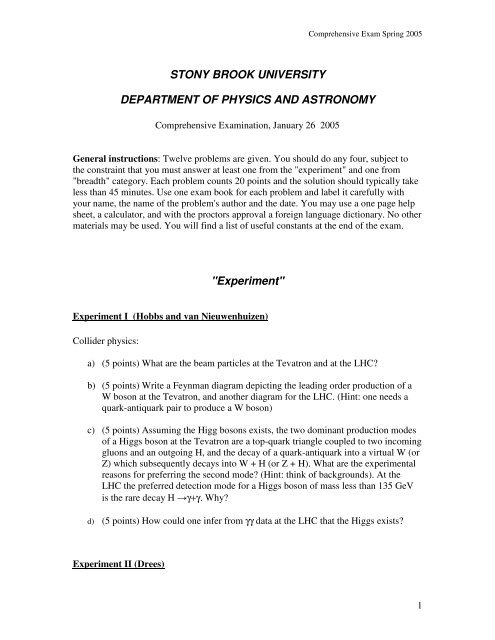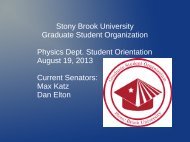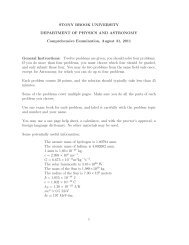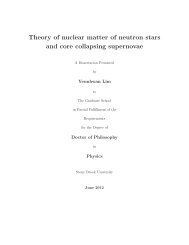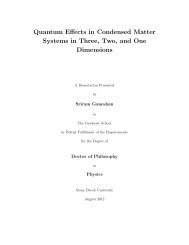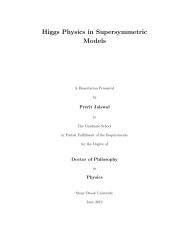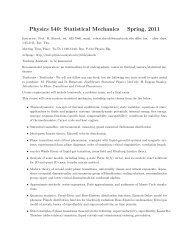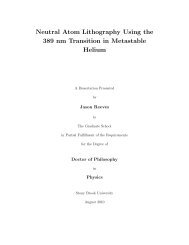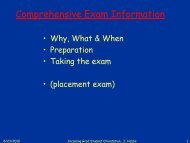Comp - Graduate Physics - Stony Brook University
Comp - Graduate Physics - Stony Brook University
Comp - Graduate Physics - Stony Brook University
Create successful ePaper yourself
Turn your PDF publications into a flip-book with our unique Google optimized e-Paper software.
<strong>Comp</strong>rehensive Exam Spring 2005<br />
STONY BROOK UNIVERSITY<br />
DEPARTMENT OF PHYSICS AND ASTRONOMY<br />
<strong>Comp</strong>rehensive Examination, January 26 2005<br />
General instructions: Twelve problems are given. You should do any four, subject to<br />
the constraint that you must answer at least one from the "experiment" and one from<br />
"breadth" category. Each problem counts 20 points and the solution should typically take<br />
less than 45 minutes. Use one exam book for each problem and label it carefully with<br />
your name, the name of the problem's author and the date. You may use a one page help<br />
sheet, a calculator, and with the proctors approval a foreign language dictionary. No other<br />
materials may be used. You will find a list of useful constants at the end of the exam.<br />
"Experiment"<br />
Experiment I (Hobbs and van Nieuwenhuizen)<br />
Collider physics:<br />
a) (5 points) What are the beam particles at the Tevatron and at the LHC<br />
b) (5 points) Write a Feynman diagram depicting the leading order production of a<br />
W boson at the Tevatron, and another diagram for the LHC. (Hint: one needs a<br />
quark-antiquark pair to produce a W boson)<br />
c) (5 points) Assuming the Higg bosons exists, the two dominant production modes<br />
of a Higgs boson at the Tevatron are a top-quark triangle coupled to two incoming<br />
gluons and an outgoing H, and the decay of a quark-antiquark into a virtual W (or<br />
Z) which subsequently decays into W + H (or Z + H). What are the experimental<br />
reasons for preferring the second mode (Hint: think of backgrounds). At the<br />
LHC the preferred detection mode for a Higgs boson of mass less than 135 GeV<br />
is the rare decay H γ+γ. Why<br />
d) (5 points) How could one infer from γγ data at the LHC that the Higgs exists<br />
Experiment II (Drees)<br />
1
<strong>Comp</strong>rehensive Exam Spring 2005<br />
The internal structure of nuclei can be described by a shell structure similar to that for<br />
electrons bound in atoms.<br />
a) (4 points) Describe the experimental evidence for the shell structure of<br />
protons and neutrons bound as nucleus.<br />
b) (6 points) Sketch the nuclear shell structure of 4 He (lowest lying s and p levels<br />
are sufficient) and compare it to that of atomic hydrogen. Discuss the main<br />
differences of nuclear and atomic shell structure.<br />
c) (6 points) What are the nuclear spin, parity, isospin and isospin projection of<br />
the ground state of 4 He and 5 He, as well as of the first excited state of 5 He<br />
Explain your answer.<br />
d) (4 points) Explain how the spin of 4 He ground state and its first and second<br />
excited state can be measured. How can you deduce parity and isospin from<br />
experimental observations<br />
Experiment III (Metcalf)<br />
One of the most common instruments to be found in any laser lab in atomic and<br />
molecular physics is the Fabry-Perot interferometer (FP). Its principle advantage is high<br />
precision for relative frequency measurements, but its principle disadvantage is<br />
ambiguity for absolute measurements.<br />
a) (4 points) How does this ambiguity arise Explain the source of the ambiguity and<br />
describe its nature.<br />
b) (4 points) As shown in the diagram, FP’s are usually made from curved mirrors<br />
in a confocal configuration because plane mirrors are hard to align and are only<br />
truly resonant for infinite size beams. What is the spacing L between mirrors in a<br />
confocal configuration whose radius of curvature is 15 cm<br />
c) (4 points) If such mirrors have an intensity reflection coefficient of r = 99%, give<br />
a numerical estimate the spectral resolution of such a FP (answer in MHz).<br />
<strong>Comp</strong>are this resolution to the optical frequency.<br />
d) (8 points) The intensity of the optical field inside a FP illuminated by resonant<br />
light varies with position in all three coordinates, x; y; and z (z is the symmetry<br />
axis, see diagram). Describe this field in some detail, either by formulas and/or by<br />
drawings. Make a careful drawing of the wavefronts of the optical field.<br />
2
<strong>Comp</strong>rehensive Exam Spring 2005<br />
Experiment IV (Mihaly)<br />
Spin resonance is widely used in physics, chemistry and biology. The magnetization M(t)<br />
of the spin system is under the influence of the external field B = B 0 +B 1 (t) (where B 0 is<br />
the static field and B 1 (t) is the oscillating excitation field). Following the excitation by<br />
B 1 (t), the spins precess around the static field. The instrument detects the magnetic dipole<br />
radiation emitted by the rotating spins (this signal is called the "free induction decay").<br />
It is customary to write the equations in a rotating frame of reference. The z axis of this<br />
reference frame is lined up with the static field, and the angular velocity of the rotation<br />
equals to the excitation frequency ω. The response of the system is described by the<br />
quasi-classical Bloch equations for a general two-level system in an external field:<br />
dM z / dt = - γM y B 1 + (M 0 - M z ) / T 1<br />
dM x / dt = γM y b 0 - M x / T 2<br />
dM y / dt = γ(M z B 1 -M x b 0 ) - M y / T 2<br />
Here the relaxation processes are characterized by two relaxation times, T 1 and T 2, the M's<br />
are components of the magnetization, M 0 is an equilibrium magnetization in a static field,<br />
and b 0 = B 0 - ω /γ. The excitation field is represented by B 1 pointing in the x direction<br />
of the rotating frame of reference. The parameter γ is called the "gyromagnetic ratio";<br />
for hydrogen nucleus γ/2π =42.58 MHz/T.<br />
a) (5 points) Assume B 1 =0. Give a simple physical reason for having two different<br />
relaxation times. What physical mechanisms are responsible for relaxation times<br />
T 1 and T 2 <br />
b) (5 points) Spin states are, in fact, quantized. In an infinitesimally small static field<br />
the population of "spin up" and "spin down" states are equal n up =n down . Estimate<br />
the ratio (n up -n down )/( n up +n down ) in a magnetic field of 0.5T for hydrogen nucleus<br />
at room temperature.<br />
c) (5 points) In pulsed spin resonance the excitation field is applied for a short time<br />
only, so that the magnetization of the sample is rotated by 90 o , perpendicular to<br />
the static field. For an excitation field of B 1 =1x10 -3 T, how long the pulse should<br />
be (Note: The static field is tuned to the resonance, B 0 = ω /γ. You may assume<br />
that the pulse length is much shorter than T 1 or T 2 . )<br />
d) (5 points) In no more than one page describe the main components of a pulsed<br />
resonance spectrometer that can be used to measure NMR on hydrogen.<br />
3
<strong>Comp</strong>rehensive Exam Spring 2005<br />
Experiment V (Evans)<br />
a) (7 points) An observer wishes to measure recession velocities of a sample of<br />
galaxies. The galaxies are assumed to have equal luminosities. What instrument<br />
should the observer use, and what galaxy ‘features’ will be observed to measure<br />
these recession velocities<br />
b) (7 points) The observer wishes to make an estimate of the Hubble Constant by<br />
making observations of the same set of galaxies. What observations should the<br />
observer make, and why<br />
c) (6 points) A few of the galaxies are observed to have negative recession<br />
velocities. What is a possible explanation for this<br />
Experiment VI (Walter)<br />
The above picture is a portion of the spectrum of a nova about 5 months past outburst.<br />
The two lines are [N II] 5755 and H I 6563 (Balmer alpha).<br />
a) (10 points) Explain the shape of the [N II] 5755 line.<br />
b) (10 points) Explain why the H I line has a different shape.<br />
In answering these questions, you should synthesize your knowledge about classical<br />
novae and atomic physics.<br />
4
<strong>Comp</strong>rehensive Exam Spring 2005<br />
"Breadth"<br />
Breadth I (van Nieuwenhuizen)<br />
a) (3 points) Which particle/field exchanges lead to the 3 forces in the Standard<br />
Model Draw for each force a simple Feynman diagram which exhibits this force.<br />
b) (4 points) Which are the quarks that make up a proton, a pion with positive<br />
charge, and a K meson with positive charge Specify the SU(3)×SU(2)×U(1)<br />
quantum numbers of the two lightest quarks.<br />
c) (5 points) What is the minimum energy an electron-antineutrino must have in<br />
order that it can produce a neutron and a positron when it hits a proton.<br />
o In the center of mass frame.<br />
o In the frame where the proton is at rest. Give analytic formulas in terms of the<br />
masses, but no numerical result.<br />
d) (3 points) Write down the Feynman graph for the lowest-order radiative<br />
correction to the anomalous magnetic moment of the muon.<br />
e) (5 points)<br />
o<br />
If one adds arbitrarily to the action for the Standard Model a mass term for<br />
the electron, instead of using the Higgs mechanism to produce such a mass<br />
term, does this violate any rigid (=global) and/or local symmetries If your<br />
answer is negative, prove this; if it is affirmative, enumerate the symmetries<br />
that are broken.<br />
o What is approximately the value of the mass of the W boson<br />
5
<strong>Comp</strong>rehensive Exam Spring 2005<br />
Breadth II (Shuryak)<br />
a) (5 points) The gold nucleus has Z=79 protons, and the total number of nucleons<br />
in known isotopes is ranging from A=Z+N=171 to A=205. Using the simple<br />
model of a homogeneous non-interacting Fermi gas of protons and neutrons in a<br />
spherical well, calculate the Fermi momentum and kinetic energy for protons and<br />
neutrons. Use the values for the radius R=6 fm and depth U 0 ~ -57 MeV.<br />
b) (7 points) Calculate the electromagnetic potential associated with its electric<br />
charge, assuming for simplicity that all charge is on the surface. Using this result<br />
and Fermi energies derived in part (a), conclude which isotope (in this model)<br />
could be the most stable isotope of gold (The actual number is N=118) What<br />
kinds of decays are expected from unstable isotopes (Ignore the proton-neutron<br />
mass difference.)<br />
c) (3 points) A neutron with negligible energy approaches a N=118 gold nucleus and<br />
is captured. What is the maximal amount of energy ∆E available for nuclear<br />
excitation<br />
d) (5 points) The resulting excited nuclei come into thermal equilibrium and emit<br />
thermal photons, from which the magnitude of temperature T is deduced. It<br />
happens to be significantly larger than ∆E /(A+1): why How does T depend on<br />
∆E <br />
Breadth III (Weinacht)<br />
Consider exciting a vapor of Na atoms with steady light from the 3 2 S 1/2 ground state to<br />
the 3 2 P 3/2 state at λ = 589nm. The lifetime of the 3 2 P 3/2 state is τ = 16 ns.<br />
a) (6 points) If you excite the atoms with light at the 3 2 S - 3 2 P 3/2 resonance, what is<br />
the maximum steady-state population that you can achieve in the 3 2 P 3/2 state<br />
Why<br />
b) (7 Points) The Rabi frequency Ω characterizes the rate of excitation. What do you<br />
need to know to calculate Ω besides what’s given above How does Ω depend on<br />
light intensity<br />
c) (6 Points) What is the general form of the equation for Ω if the optical frequency<br />
is detuned from the atomic resonance by an amount δ How is this related to the<br />
maximum achievable excited state population<br />
6
<strong>Comp</strong>rehensive Exam Spring 2005<br />
Breadth IV (McCoy)<br />
Pick any element (such as hydrogen, helium, carbon, argon, iron, etc.) you wish and for<br />
this element:<br />
a) (10 points) Sketch its phase diagram in the P,T plane and give (approximately) the<br />
experimentally determined values of P and T for phase boundaries and critical<br />
points and give the nature of the order parameter in the various phases.<br />
b) (5 points) Describe how experimentally the phase diagram and order parameters<br />
of the phases are determined.<br />
c) (5 points) Give a theoretical microscopic explanation for the existence of the<br />
different phases on the phase diagram you choose in part a).<br />
Breadth V (Yahil)<br />
The nonrelativistic linear equation for small density perturbations in a pressureless,<br />
matter-dominated universe is<br />
2<br />
d δ dδ<br />
+ 2H 2<br />
( t) − 4π Gρb<br />
( t)<br />
δ = 0 . (1)<br />
dt dt<br />
−<br />
Here H ( t) = R ( t) 1<br />
dR dt is the Hubble function, ( )<br />
R t is the scale factor of the<br />
universe. δ = ρ / ρ b<br />
− 1 is the relative density perturbation away from the mean<br />
background density ( t)<br />
ρ .<br />
b<br />
a) (5 points) How would you interpret the second and third terms of Eq. (1)<br />
b) (5 points) Write down the equation for the acceleration of the universe,<br />
and use this equation to show that<br />
2 2<br />
d R dt ,<br />
δ ∝ H ( t)<br />
(2)<br />
is a decaying solution of Eq. (1), i.e., show that H ( t ) is a solution and that it<br />
decays with time.<br />
c) (5 points) Show that the other solution of Eq. (1) is:<br />
t dR t <br />
δ ∝ D ( t) = H ( t)<br />
dt′<br />
0<br />
<br />
dt′<br />
<br />
(3)<br />
<br />
[Hint: look for a solution of the form δ = Hy and use the fact that H is a solution<br />
of Eq. (1).]<br />
d) (5 points) Neglecting the cosmological constant, how does the solution in Eq. (3)<br />
behave for cosmological density parameters Ω = 1 and Ω = 0 Deduce the past<br />
growth of perturbations in a universe whose current density parameter is<br />
Ω<br />
0<br />
= 0.25 and the growth expected in the future. You may neglect dark energy,<br />
which has little effect on the growth of perturbations.<br />
( ′)<br />
−2<br />
7
<strong>Comp</strong>rehensive Exam Spring 2005<br />
Breadth VI (Evans)<br />
Stars form in molecular clouds comprised mostly of molecular hydrogen, but containing<br />
trace amounts of other molecules such as CO and HCN. The kinematics and quantity of<br />
molecular hydrogen can be traced by using the 115 GHz rotational transition of CO,<br />
which is collisionally excited by molecular hydrogen. In addition, the CO transition is<br />
observed to be optically thick to the CO emission in molecular clouds.<br />
The CO luminosity,<br />
'<br />
L<br />
CO<br />
of a spherical molecular cloud is given by,<br />
'<br />
L<br />
CO<br />
2<br />
= π R T ∆v<br />
1<br />
CO<br />
where R is the radius of the cloud and<br />
T CO<br />
∆ v is the flux of the CO emission line<br />
2<br />
expressed in terms of the average radiation temperature over the areaπ R and the<br />
velocity width of the line. For a cloud in virial equilibrium, twice the time-averaged<br />
kinematic energy is equal to the absolute value of the time-averaged<br />
potential energy.<br />
a) (8 points) Use equation (1) and the condition of virial equilibrium to derive an<br />
expression for the molecular hydrogen mass in terms of CO luminosity, the<br />
radiation temperature, and the cloud density. For this derivation, adopt the<br />
following expression for the kinetic energy:<br />
0.5<br />
v<br />
2<br />
M gas<br />
∆ 2<br />
where M<br />
gas<br />
is the mass of molecular gas (i.e., the cloud mass) and ∆ v is the<br />
same velocity as in equation (1).<br />
b) (4 points) What must be true of the radiation temperature and density in order for<br />
the CO luminosity to be proportional to the molecular hydrogen mass Is this<br />
physically feasible<br />
c) (8 points) If CO observations of an ensemble of spatially resolved giant molecular<br />
clouds with a range of CO luminosities are obtained, how can these observations<br />
be used to test the proportionality between the CO luminosity and the molecular<br />
hydrogen mass<br />
8
<strong>Comp</strong>rehensive Exam Spring 2005<br />
"Constants and Unit Conversions"<br />
Avogadro number N A = 6×10 23 mol -1<br />
Boltzmann constant k = 1.38×10 -23 J/K<br />
Planck’s constant h = 6.62×10 -34 Js<br />
Speed of light<br />
c = 3×10 8 m/s<br />
c = 197 MeV fm<br />
electric charge<br />
e = 1.6×10 -19 C<br />
fine structure constant α = e 2 /4π ε 0 c = 1/137<br />
Gravitational constant G = 6.67×10 11 m 3 /kg s 2<br />
Mass of Sun<br />
M o = 1.99×10 30 kg<br />
Radius of Sun<br />
R o = 6.97×10 8 m<br />
Mass of the sodium atom: M Na = 3.818×10 -26 kg<br />
Sodium D 1 oscillator strength: f 1 = 0.655<br />
Sodium D 2 oscillator strength: f 2 = 0.327<br />
Atomic mass of Al: 27<br />
Density of Al: 2.7 g/cm 3<br />
1 eV = 1.6×10 -19 J<br />
1 eV/c 2 = 1.78×10 -36 kg<br />
1 barn = 1×10 -28 m 2<br />
9


